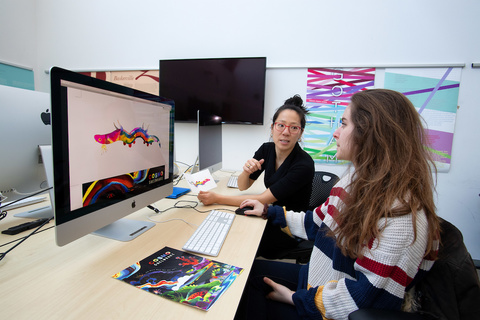The University of Iowa School of Art and Art History is now the University of Iowa School of Art, Art History, and Design.
The Iowa Board of Regents approved the school’s name change in June and the university adopted the name beginning on July 1, 2024. The new title reflects the growth of Iowa’s art programs and offerings while recognizing the university’s long history of design expertise as part of its studio art and art history curriculum.
The name change also showcases the influence of design innovation throughout the school’s programs and its current degree offerings, which include a Bachelor of Fine Arts, Master of Arts, and Master of Fine Arts in 3D design and graphic design.
“By incorporating design into our name, we can better represent our faculty expertise, appeal more to students interested in art and design careers and affirm our position as a leader in contemporary arts education,” said Downing Thomas, the school’s interim director. “The name change signifies our commitment to a design-centric mindset and ensures that design practices are interwoven throughout all of our educational offerings.”
A history of collaboration, emphasis on design
The School of Art and Art History has long been committed to interdisciplinary work, tracing back to the early 20th century when the “Iowa Idea” emerged. This concept, which was revolutionary at the time, integrated art and design into the broader liberal arts curriculum—promoting creativity, critical thinking, and interdisciplinary collaboration.
Before the Iowa Idea, institutions typically taught art and art history as two distinct disciplines, but Iowa became a model that inspired the fusing of many programs across the country.
The Iowa Idea emphasizes cross-disciplinary work, which is also core to the mission of the College of Liberal Arts and Sciences. Today, the school continues to take that concept even further, offering unique programming that connects art, engineering, science, and technology—often through design.
An example of that interconnectivity is the school’s beloved bike-building class, blending engineering and art through sculpture, ceramics, and metals. The course is part of Iowa’s elite 3D design program, which has taken students as far as New York City and Milan, Italy to showcase breathtaking work including unique furniture pieces and stunning light fixtures.
“Collaboration is at the heart of a vibrant liberal arts education,” said Roland Racevskis, associate dean of the arts and humanities in the college. “Our art programs have been modeling and engaging this way for over a century, and this change is simply a reflection of that commitment to creative collaboration across disciplines.”
Opening more doors for students
Since 2018, more than 40 percent of Iowa students enrolled in the School of Art and Art History’s Studio Arts programs have been either 3D design or graphic design. The updated name reflects the long-established role of design in the school’s mission and its comprehensive embrace of design methodologies that inspire creativity and innovation across the curriculum.

“While design is a distinct and varied discipline, artists are all to some degree designers,” said Andrew Casto, associate professor and head of Ceramics. “At each stage of the creative process, we input a project’s parameters and seek elegant solutions to complete the creative act. This ethos is at the heart of our work, and as such it feels appropriate to cement this language in our name.”
“Our commitment is to our students and part of that mission is making them aware of all that we have to offer,” said Thomas. “We know design is a growing field. Incorporating it into our name will help us appeal to more students—especially those interested in a creative, fulfilling career involving design.”
To learn more about the University of Iowa School of Art, Art History, and Design, visit art.uiowa.edu.